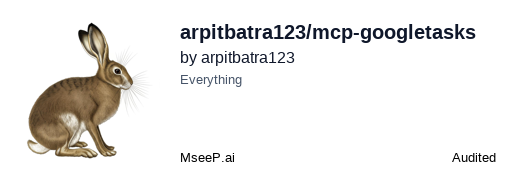Google Tasks Mcp Server
This Model Context Protocol (MCP) server provides a connection between Claude and Google Tasks, enabling you to manage your task lists and tasks directly through Claude.
Overview
What is MCP Google Tasks?
The Model Context Protocol (MCP) Google Tasks is a server that acts as a bridge between Claude, an AI assistant, and Google Tasks. This integration allows users to manage their task lists and individual tasks directly through Claude, streamlining the process of task management.
Features of MCP Google Tasks
- Seamless Integration: Connects Claude with Google Tasks for efficient task management.
- User-Friendly Interface: Designed for ease of use, allowing users to interact with their tasks effortlessly.
- Real-Time Updates: Changes made in Claude are reflected in Google Tasks instantly, ensuring that users always have the latest information.
- Task Organization: Users can create, edit, and delete tasks, as well as organize them into lists for better management.
- Accessibility: Available to anyone with a Google account, making it easy to start managing tasks right away.
How to Use MCP Google Tasks
- Set Up Your Google Account: Ensure you have a Google account and are logged in.
- Connect to Claude: Access Claude and navigate to the task management feature.
- Create a Task: Use voice commands or text input to create new tasks.
- Manage Your Tasks: Edit, delete, or organize tasks as needed through Claude.
- Sync with Google Tasks: All changes will automatically sync with your Google Tasks account.
Frequently Asked Questions
What is the purpose of MCP Google Tasks?
The MCP Google Tasks serves to enhance productivity by allowing users to manage their tasks through an AI assistant, making task management more efficient and accessible.
Do I need a special account to use MCP Google Tasks?
No, you only need a standard Google account to access and utilize the features of MCP Google Tasks.
Can I access my tasks from multiple devices?
Yes, since MCP Google Tasks syncs with Google Tasks, you can access your tasks from any device where you are logged into your Google account.
Is there a cost associated with using MCP Google Tasks?
The service is free to use as long as you have a Google account.
How does MCP Google Tasks ensure data security?
MCP Google Tasks follows standard security protocols to protect user data, ensuring that your tasks and personal information remain secure.
Details
Google Tasks MCP Server
This Model Context Protocol (MCP) server provides a bridge between Claude and Google Tasks, allowing you to manage your task lists and tasks directly through Claude.
<a href="https://glama.ai/mcp/servers/@arpitbatra123/mcp-googletasks"> <img width="380" height="200" src="https://glama.ai/mcp/servers/@arpitbatra123/mcp-googletasks/badge" alt="Google Tasks Server MCP server" /> </a>Note: All ( bar some edits ) code in this project was "vibe coded" - generated with Claude with instructions from me.
Features
This MCP server provides the following functionality:
Task List Management
list-tasklists- List all your task listsget-tasklist- Get details about a specific task listcreate-tasklist- Create a new task listupdate-tasklist- Update an existing task listdelete-tasklist- Delete a task list
Task Management
list-tasks- List all tasks in a task listget-task- Get details about a specific taskcreate-task- Create a new taskupdate-task- Update an existing taskdelete-task- Delete a taskcomplete-task- Mark a task as completedmove-task- Move a task (reorder or change parent)clear-completed-tasks- Clear all completed tasks from a list
Setup Instructions
1. Create Google Cloud Project & Enable API
- Go to the Google Cloud Console
- Create a new project
- Navigate to "APIs & Services" > "Library"
- Search for "Google Tasks API" and enable it
- Go to "APIs & Services" > "Credentials"
- Click "Create Credentials" > "OAuth Client ID"
- Configure the OAuth consent screen (External is fine for personal use)
- For Application Type, select "Web application"
- Add "http://localhost:3000" as an authorized redirect URI
- Create the client ID and secret
2. Configure Claude for Desktop
- Install Claude for Desktop
- Open the Claude configuration file:
- MacOS:
~/Library/Application Support/Claude/claude_desktop_config.json - Windows:
%APPDATA%\Claude\claude_desktop_config.json
- MacOS:
- Add the Google Tasks MCP server configuration:
{
"mcpServers": {
"google-tasks": {
"command": "node",
"args": ["/path/to/google-tasks-mcp/build/index.js"],
"env": {
"GOOGLE_CLIENT_ID": "your_client_id_here",
"GOOGLE_CLIENT_SECRET": "your_client_secret_here",
"GOOGLE_REDIRECT_URI": "http://localhost:3000/oauth2callback"
}
}
}
}
Replace the path and credentials with your own values.
3. Build and Run the Server
Installing via Smithery
To install Google Tasks Integration Server for Claude Desktop automatically via Smithery:
npx -y @smithery/cli install @arpitbatra123/mcp-googletasks --client claude
Manual Installation
- Install dependencies:
npm install
- Build the server:
npm run build
- Restart Claude for Desktop
Authentication Flow
When you first use the Google Tasks MCP server:
- Use the
authenticatetool to get an authorization URL - Visit the URL in your browser and sign in with your Google account
- After authorizing, you'll receive a code on the browser page
- Use the
set-auth-codetool with this code to complete authentication - You can now use all other tools to interact with Google Tasks
Note that your authentication is session-based and will be lost when you restart the server. You'll need to re-authenticate each time.
Requirements
- Node.js 14+
- Claude for Desktop (latest version)
- Google Cloud Project with Tasks API enabled
Screenshot

License
This project is for demonstration purposes only. Use at your own risk.
Server Config
{
"mcpServers": {
"mcp-googletasks": {
"command": "docker",
"args": [
"run",
"-i",
"--rm",
"ghcr.io/metorial/mcp-container--arpitbatra123--mcp-googletasks--mcp-googletasks",
"node build/index.js"
],
"env": {
"GOOGLE_CLIENT_ID": "google-client-id",
"GOOGLE_CLIENT_SECRET": "google-client-secret",
"GOOGLE_REDIRECT_URI": "google-redirect-uri"
}
}
}
}
